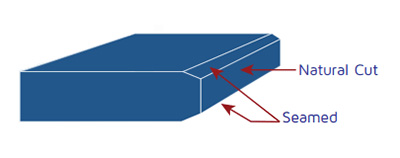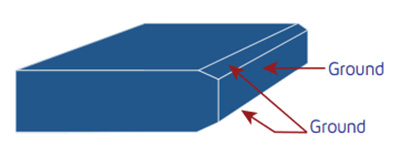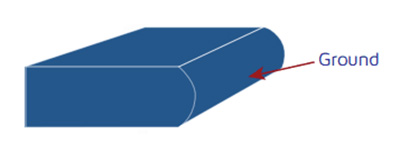Glass materials can receive many different types of glass edge treatments, each of which will uniquely affect the overall functionality and performance of the finished piece. Edging can improve safety, aesthetics, functionality, and cleanliness while improving dimensional tolerance and helping to prevent chipping.
Below, we’ll explore five common glass edge types and their unique benefits.
Cut and Swipe or Seamed Edges
Also referred to as safety seams or swiped edges, this type of glass edging — in which a sanding belt is used to lightly sand off sharp edges — is primarily employed to ensure the finished piece is safe for handling. This style of edging does not provide a smooth, cosmetically finished edge and is not used for decorative purposes; therefore, this method is ideal for applications in which the edge of the glass piece will not be exposed, such as the glass installed into the frame of fireplace doors.

Grind and Chamfer (Bevel)
This type of edging involves flat grinding glass edges until they are smooth and then running the top and bottom edges along a belt to eliminate sharpness and remove chips. The resulting glass piece features a smooth chamfer top and bottom with an exterior ground edge. Available with straight or curved bevels, chamfered edges are most often seen on frameless mirrors, such as those on medicine cabinets.

Pencil Grind
Pencil grinding, achieved through the use of a diamond-embedded grinding wheel, is used to create a slightly rounded edge and allows for a frosty, satin, or matte glass finish. “Pencil” refers to the edge radius, which is similar to a pencil or C shape. This grind is also referred to as a Semi-Polished Edge.

Pencil Polish
Pencil polished glass edges are ground smooth, finished with a shiny or glossy polish, and feature a slight curve. The unique finish makes pencil polishing ideal for aesthetics-focused applications. Like pencil-ground edges, the edge’s radius is similar to a pencil or C shape.

Flat Polish
This method involves cutting the edges of the glass and then flat polishing them, resulting in a sleek appearance and shiny or glossy finish. Most flat-polished applications also employ a small 45° angle chamfer on the top and bottom glass edges to remove sharpness and “chatter” which can also be polished.

Post time: Aug-14-2020



